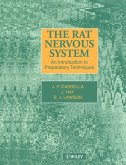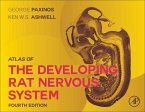The Mouse Nervous System provides a comprehensive account of the central nervous system of the mouse. The book is aimed at molecular biologists who need a book that introduces them to the anatomy of the mouse brain and spinal cord, but also takes them into the relevant details of development and organization of the area they have chosen to study. The Mouse Nervous System offers a wealth of new information for experienced anatomists who work on mice. The book serves as a valuable resource for researchers and graduate students in neuroscience.
Systematic consideration of the anatomy and connections of all regions of the brain and spinal cord by the authors of the most cited rodent brain atlases A major section (12 chapters) on functional systems related to motor control, sensation, and behavioral and emotional states A detailed analysis of gene expression during development of the forebrain by Luis Puelles, the leading researcher in this area Full coverage of the role of gene expression during development and the new field of genetic neuroanatomy using site-specific recombinases Examples of the use of mouse models in the study of neurological illness
Hinweis: Dieser Artikel kann nur an eine deutsche Lieferadresse ausgeliefert werden.
Systematic consideration of the anatomy and connections of all regions of the brain and spinal cord by the authors of the most cited rodent brain atlases A major section (12 chapters) on functional systems related to motor control, sensation, and behavioral and emotional states A detailed analysis of gene expression during development of the forebrain by Luis Puelles, the leading researcher in this area Full coverage of the role of gene expression during development and the new field of genetic neuroanatomy using site-specific recombinases Examples of the use of mouse models in the study of neurological illness
Hinweis: Dieser Artikel kann nur an eine deutsche Lieferadresse ausgeliefert werden.
A mouse may appear insignificant due to its small size, but its complex nervous system has played a significant role in neuroscience studies. Such a system is intricate enough for a book, the thickness of 4 adult mice lying on top of one another, to be written about it. There were three main reasons for such a book: it would serve as an introductory guide to neuroscience for molecular biologists, provide insight on the new discoveries of gene expression, and highlight that mice are unique as compared to the more commonly studied rats. The Mouse Nervous System, edited by Charles Watson, George Paxinos, and Luis Puelles, does just that by thoroughly venturing through the crevices of the central nervous system of the mouse.
To the general public, the mouse brain may appear to be a simple chunk of mass, but neurologists and anatomists would beg to differ. This book, having been composed by professionals in the fields of neurology and anatomy, shows how complicated the mouse brain actually is. Of the 33 chapters devoted to the anatomy of the mouse brain, the first three are about its stages of development. These earlier chapters also include past experiments which provide support for the facts about development. For more than half of the book, from chapter four until chapter fifteen, the structure of the brain is presented as a whole and then as individual parts. Thus, the text and real life anatomy figures both serve as dissections of the mouse brain. Furthermore, images throughout the book are useful and relevant not only to those who learn from viewing pictures but also serve as supplemental information for those who learn from reading text.
After introducing the reader to the fundamentals of the mouse brain, the systems and their respective functions are presented in chapters 16 through 27. With most important information already provided in the first half of the book, these later chapters serve to assist the reader in connecting the dots on how all those structures function together. In addition to providing background knowledge about the nervous system of the mouse, this book is also user-friendly because a table of contents that is chapter-specific is present at the beginning of each respective chapter. The helpfulness continues at the conclusion of chapters where a list of references is presented so the reader can read more about an intriguing subject. Perhaps the most unique feature of this book is the abbreviations list which is located near the end of certain chapters. This list is beneficial to both the writers and readers; the writers can provide the intended definitions which will lessen the likelihood that the reader searches and finds an inaccurate abbreviation.
A textbook of this size is expected to contain an abundance of information about the nervous system of the mouse, which it does. Although its content is focused on an audience of molecular biologists and neuroscientists, the cleverly organized layout offers enough background knowledge for any reader to be able to understand the later chapters when human diseases, using the mouse brain as a model, are discussed. This book is highly recommended for someone striving to learn about the mouse nervous system in great detail.-Katalina J. Sher, Jack W. Tsao Department of Neurology, Uniformed Services University of the Health Services
To the general public, the mouse brain may appear to be a simple chunk of mass, but neurologists and anatomists would beg to differ. This book, having been composed by professionals in the fields of neurology and anatomy, shows how complicated the mouse brain actually is. Of the 33 chapters devoted to the anatomy of the mouse brain, the first three are about its stages of development. These earlier chapters also include past experiments which provide support for the facts about development. For more than half of the book, from chapter four until chapter fifteen, the structure of the brain is presented as a whole and then as individual parts. Thus, the text and real life anatomy figures both serve as dissections of the mouse brain. Furthermore, images throughout the book are useful and relevant not only to those who learn from viewing pictures but also serve as supplemental information for those who learn from reading text.
After introducing the reader to the fundamentals of the mouse brain, the systems and their respective functions are presented in chapters 16 through 27. With most important information already provided in the first half of the book, these later chapters serve to assist the reader in connecting the dots on how all those structures function together. In addition to providing background knowledge about the nervous system of the mouse, this book is also user-friendly because a table of contents that is chapter-specific is present at the beginning of each respective chapter. The helpfulness continues at the conclusion of chapters where a list of references is presented so the reader can read more about an intriguing subject. Perhaps the most unique feature of this book is the abbreviations list which is located near the end of certain chapters. This list is beneficial to both the writers and readers; the writers can provide the intended definitions which will lessen the likelihood that the reader searches and finds an inaccurate abbreviation.
A textbook of this size is expected to contain an abundance of information about the nervous system of the mouse, which it does. Although its content is focused on an audience of molecular biologists and neuroscientists, the cleverly organized layout offers enough background knowledge for any reader to be able to understand the later chapters when human diseases, using the mouse brain as a model, are discussed. This book is highly recommended for someone striving to learn about the mouse nervous system in great detail.-Katalina J. Sher, Jack W. Tsao Department of Neurology, Uniformed Services University of the Health Services








